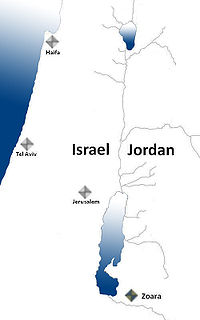Related Research Articles
Syria Palaestina was a Roman province between 135 AD and about 390. It was established by the merger of Roman Syria and Roman Judaea, following the suppression of the Bar Kokhba revolt in 135 AD. Shortly after 193, the northern regions were split off as Syria Coele in the north and Phoenice in the south, and the province Syria Palaestina was reduced to Judea. The earliest numismatic evidence for the name Syria Palaestina comes from the period of emperor Marcus Aurelius, although the Classical Greek version of name has been recorded in usage since at least the 5th century BC.

Dardanus was an ancient city in the Troad. It was sometimes called Dardania, a term used also for the district around it. Pliny the Elder called it Dardanium.
The archiepiscopal see of Caesarea in Palaestina, also known as Caesarea Maritima, is now a metropolitan see of the Eastern Orthodox Patriarchate of Jerusalem and also a titular see of the Catholic Church. It was one of the earliest Christian bishoprics, and was a metropolitan see at the time of the First Council of Nicaea, but was later subjected to the Patriarchate of Jerusalem. The city remained largely Christian until the Crusades, its bishop maintaining close ties to the Byzantine Empire. After the establishment of the Kingdom of Jerusalem by the crusaders, the see was transformed into a Latin archdiocese, subordinate to the Latin patriarch of Jerusalem.

Zoara, the biblical Zoar, previously called Bela, was one of the five "cities of the plain" – a pentapolis apparently located along the lower Jordan Valley and the Dead Sea plain and mentioned in the Book of Genesis. It was said to have been spared the "brimstone and fire" which destroyed Sodom and Gomorrah in order to provide a refuge for Lot and his daughters. It is mentioned by Josephus; by Ptolemy ; and by Eusebius and Saint Jerome in the Onomasticon.

Barca, also called Barce, was an ancient city and former bishopric, which survives as both a Latin Catholic and an Orthodox titular see.
Nazianzus or Nazianzos, also known as Nandianulus, was a small town of ancient Cappadocia, and in the late Roman province of Cappadocia Tertia, located 24 Roman miles to the southeast of Archelais. In the Jerusalem Itinerary it is miswritten as Nathiangus.
Harpasa was a city and bishopric in ancient Caria in Roman Asia Minor, which only remains a Latin Catholic titular see.
Cotenna or Kotenna was a city in the Roman province of Pamphylia I in Asia Minor. It corresponds to modern Gödene, near Konya, Turkey.
Attuda or Attouda was a town of ancient Caria and later in the Roman province of Phrygia Pacatiana. There are coins of the place with the epigraph Ἱερὰ Βουλὴ Ἀττουδέων, of the time of Augustus and later. The coins show that the Men Carus was worshipped there.
Augustopolis may refer to the following Ancient places :
Arindela was a town in the late Roman province of Palaestina Salutaris, also called Palaestina Tertia. It corresponds to modern Gharandal, in the region of Tafilah, south Jordan.

Judea or Judaea, and the modern version of Judah is the ancient Hebrew and Israelite biblical, the contemporaneous Latin, and the modern-day name of the mountainous southern part of the region of Palestine. The name originates from the Hebrew name Yehudah, a son of the Jewish patriarch Jacob/Israel, and Yehudah's progeny forming the biblical Israelite tribe of Judah (Yehudah) and later the associated Kingdom of Judah, which the 1906 Jewish Encyclopedia dates from 934 until 586 BCE. The name of the region continued to be incorporated through the Babylonian conquest, Persian, Hellenistic, and Roman periods as Yehud, Yehud Medinata, Hasmonean Judea, and consequently Herodian Judea and Roman Judea, respectively.
Augustopolis in Phrygia was a city and bishopric in the Roman province of Phrygia, which remains a Latin Catholic and an Orthodox titular see.
The Diocese of Scythopolis is a titular see in Israel/Jordan and was the Metropolitan of the Roman province of Palestina II. It was centered on Modern Beth Shean (Bêsân).
Bacatha in Palestina was a town and episcopal see in the late Roman province of Palaestina Salutaris or Palaestina Tertia, the provincial capital and metropolitan see of which was Petra. As a diocese that is no longer residential, it is listed in the Annuario Pontificio among titular sees.
Amathus (Ancient Greek: Ἀμαθοῦς or τὰ Ἀμαθά; in Eusebius, Ἀμμαθοὺς. Hebrew: עמתו was a fortified city east of the Jordan River, in modern-day Jordan.
Meloë was a town in ancient Lycia, located near Cape Kilidonia.
Parnassus or Parnassos was a town in the northern part of ancient Cappadocia, on the right bank of the Halys River, and on or near a hill, to which it owed its name, on the road between Ancyra and Archelais, about 63 miles west of the latter town. It became a bishopric and remains a Roman Catholic titular see.
Catholic dioceses in the Holy Land and Cyprus is a multi-rite, international episcopate in Israel and Cyprus.
The Council of Jerusalem of 536 was a meeting of Chalcedonian representatives of the church of the Three Palestines to condemn certain persons accused of the Monophysite heresy. It was convoked at the initiative the Roman emperor Justinian I following the forced resignation of the Patriarch Anthimus I of Constantinople in February or March, an event in which Pope Agapetus I had played the main role.
References
- ↑ Michel Lequien, Oriens christianus in quatuor Patriarchatus digestus, Paris 1740, Vol III, coll. 727-728
- ↑ Pius Bonifacius Gams, Series episcoporum Ecclesiae Catholicae, Leipzig 1931, p. 454
- ↑ Annuario Pontificio 2013 (Libreria Editrice Vaticana 2013 ISBN 978-88-209-9070-1), p. 842